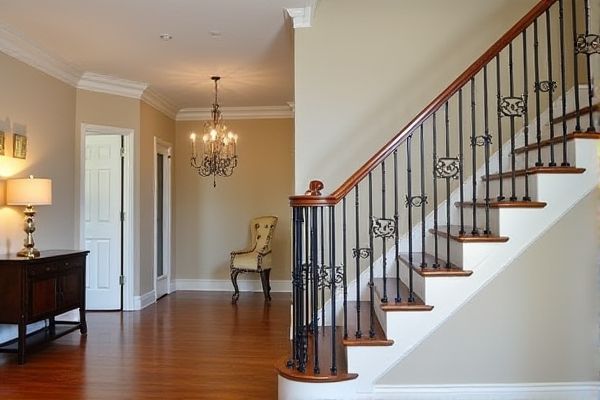
Wrought iron balusters offer intricate designs and superior durability, lending a classic elegance to staircases, while steel balusters are typically more affordable and provide a modern, sleek appearance with excellent strength. Explore the rest of the article to determine which material best suits Your style and functional needs.
Table of Comparison
| Feature | Wrought Iron Balusters | Steel Balusters |
|---|---|---|
| Material Composition | Pure iron with low carbon content | Alloy of iron and carbon with added elements |
| Durability | High corrosion resistance, durable over time | Strong but prone to rust without treatment |
| Weight | Heavier, solid construction | Lighter, varies by gauge |
| Design Flexibility | Highly malleable, detailed ornamental designs | Typically simpler, modern styles |
| Maintenance | Low; less prone to rust and damage | Requires regular painting or coating |
| Cost | Higher due to craftsmanship and material | Generally more affordable |
| Installation | Requires skilled labor | Easy to install with basic tools |
| Common Uses | Historic homes, decorative railings | Modern homes, minimalist designs |
Introduction: Wrought Iron vs Steel Balusters
Wrought iron balusters offer traditional craftsmanship with intricate designs and a naturally rust-resistant composition, making them ideal for historic or classic architectural styles. Steel balusters provide superior strength, durability, and cost-efficiency, often featuring powder-coated finishes for enhanced weather resistance in modern or industrial applications. Both materials differ significantly in weight, maintenance requirements, and aesthetic appeal, influencing their suitability for various stair railing projects.
Material Composition and Properties
Wrought iron balusters consist primarily of nearly pure iron with very low carbon content, offering excellent malleability and corrosion resistance, ideal for intricate ornamental designs. Steel balusters are typically made from carbon steel or stainless steel, providing greater tensile strength and durability but less flexibility in shaping compared to wrought iron. The higher carbon content in steel increases hardness and structural integrity, making steel balusters suitable for modern, minimalist architectural styles that demand robustness.
Durability and Strength Comparison
Wrought iron balusters offer exceptional durability with their corrosion-resistant properties and ability to withstand harsh weather conditions, making them ideal for long-term outdoor use. Steel balusters provide superior strength and structural support due to their solid composition and resistance to bending under heavy loads. Your choice between wrought iron and steel balusters should consider the balance between aesthetic appeal and the specific strength requirements of your railing project.
Design and Aesthetic Differences
Wrought iron balusters offer intricate, handcrafted designs with ornate patterns, providing a classic, elegant aesthetic ideal for traditional and vintage architecture. Steel balusters tend to feature sleek, minimalist lines with modern geometric shapes, catering to contemporary and industrial design preferences. The choice between wrought iron and steel balusters significantly influences the visual impact and character of staircases and railings.
Installation Process and Compatibility
Wrought iron balusters typically require custom fitting due to their hand-forged nature, making the installation process more time-intensive and suited for traditional or classic architectural styles. Steel balusters offer greater compatibility with modern designs, featuring uniform dimensions that simplify installation and allow for compatibility with a wider range of railing systems. Your choice between the two should consider the balance between installation complexity and the style compatibility of your railing project.
Maintenance Requirements
Wrought iron balusters demand regular maintenance such as rust prevention treatment and repainting to retain their classic appearance and durability. Steel balusters offer lower maintenance needs due to their enhanced resistance to corrosion and weathering, often only requiring occasional cleaning and touch-ups. Your choice will depend on the balance between the aesthetic appeal of wrought iron and the practical ease of steel upkeep.
Cost Analysis: Wrought Iron vs Steel
Wrought iron balusters typically cost more upfront due to their handcrafted nature and intricate designs, averaging $25 to $50 per baluster, compared to steel balusters ranging from $10 to $20 per piece. The durability and corrosion resistance of steel often reduce long-term maintenance expenses, making steel balusters more cost-effective over time despite the higher initial investment in wrought iron. When factoring installation complexity and potential customization, wrought iron's premium price reflects both artistry and longevity, whereas steel balusters offer a budget-friendly, low-maintenance alternative.
Customization Options
Wrought iron balusters offer extensive customization options, including intricate scrollwork, twisted designs, and hand-forged detailing that enhance aesthetic appeal. Steel balusters provide more straightforward, modern styles with customizable finishes such as powder coating and paint colors to match contemporary designs. Both materials allow tailored dimensions and shapes, but wrought iron excels in ornamental customization for traditional or classic settings.
Common Applications and Use Cases
Wrought iron balusters are frequently used in traditional and ornate architectural settings, such as historic homes, staircases with intricate designs, and decorative railings, offering a classic and elegant appearance. Steel balusters are favored for modern and industrial-style applications due to their strength, durability, and sleek, minimalist look, making them ideal for commercial buildings, outdoor stairways, and contemporary homes. Your choice between wrought iron and steel balusters will depend on the desired aesthetic and structural requirements of your project.
Which Baluster Type is Best for Your Project?
Wrought iron balusters offer classic elegance and superior durability with intricate designs ideal for traditional or ornate railings, while steel balusters provide a modern, cost-effective alternative with high strength and lower maintenance. Choosing the best baluster type depends on the architectural style, budget constraints, and maintenance preferences of your project. For historic restorations or upscale residential settings, wrought iron is often preferred, whereas steel balusters are suited for contemporary designs and commercial applications requiring longevity and affordability.
 homyna.com
homyna.com